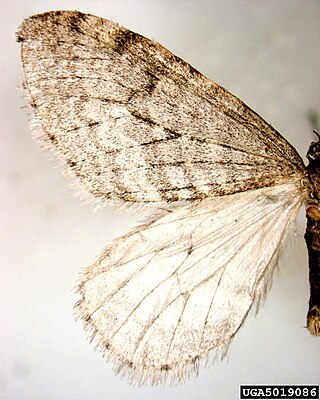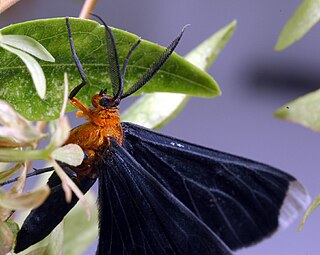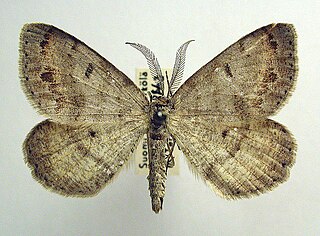
The geometer moths are moths belonging to the family Geometridae of the insect order Lepidoptera, the moths and butterflies. Their scientific name derives from the Ancient Greek geo γεω, and metron μέτρον "measure" in reference to the way their larvae, or inchworms, appear to measure the earth as they move along in a looping fashion. Geometridae is a very large family, containing around 23,000 described species; over 1400 species from six subfamilies are indigenous to North America alone. A well-known member is the peppered moth, Biston betularia, which has been the subject of numerous studies in population genetics. Several other geometer moths are notorious pests.

The winter moth is a moth of the family Geometridae. It is an abundant species in Europe and the Near East and a famous study organism for evaluating insect population dynamics. It is one of very few lepidopterans of temperate regions in which adults are active in late autumn and early winter. The adults use endothermy for movement in these cold temperatures. The females of this species are virtually wingless and cannot fly, but the males are fully winged and fly strongly. After the initial frosts of late fall, the females emerge from their pupae, walk to and up trees and emit pheromones in the evening to attract males. After fertilization, they ascend to lay, on average, around 100 eggs each. Typically, the larger the female moth is, the more eggs she lays.

The feathered thorn is a moth of the family Geometridae. It was first described by Carl Linnaeus in 1761.

Eumacaria is a monotypic moth genus in the family Geometridae described by Packard in 1873. Its only species, Eumacaria madopata, the brown-bordered geometer moth, was first described by Achille Guenée in 1857. It is found in North America, where it has been recorded from British Columbia, northern Washington, southern Saskatchewan, from Maine to Florida, South Dakota, North Dakota, Nebraska, Wyoming, Idaho, Colorado and New Mexico. The habitat consists of orchards and shrublands. The species is listed as threatened in Connecticut.

Nematocampa is a genus of moths in the family Geometridae.

Eusarca confusaria, the confused eusarca, is a moth species of the family Geometridae that occurs in North America and Brazil. It is the only member of the genus Eusarca that inhabits the northern portion of the United States and Canada.

Operophtera bruceata, the Bruce spanworm, hunter's moth, or native winter moth is a moth of the family Geometridae. The species was first described by George Duryea Hulst in 1886. It is found from coast to coast in southern Canada and the northern parts of the United States.

Nematocampa resistaria, the filament bearer, bordered thorn or horned spanworm moth, is a moth of the family Geometridae. The species was first described by Gottlieb August Wilhelm Herrich-Schäffer in 1856. It is found in North America from British Columbia to Nova Scotia, south to Florida and California.

Melanchroia chephise, the white-tipped black or snowbush spanworm, is a moth of the family Geometridae. It is found from Florida and Texas, south to Paraguay. Strays have been recorded from Arizona, Oklahoma, Arkansas, Kansas and Illinois.

Speranza pustularia, the lesser maple spanworm, is a moth of the family Geometridae. Adults are on wing from May to July in the south and from June to August in the north. There is one generation per year.

Macaria loricaria, the false Bruce spanworm or Eversmann's peacock, is a moth of the family Geometridae. It is found from Fennoscandia and the Baltic states to Sakhalin. It is also found in North America, where it is found from Alaska to Newfoundland and New York, south to Colorado.

Ennomos subsignaria, the elm spanworm moth, is a moth of the family Geometridae. The species was first described by Jacob Hübner in 1823. It is found in North America from Texas (south) to Alberta (northwest) and east to the Atlantic coast. It is recorded infrequently in Great Britain through accidental importation in asparagus.

Lycia ursaria, the stout spanworm moth or bear, is a moth of the family Geometridae. The species was first described by Francis Walker in 1860. It is found in southern Canada and the northern United States, south to New Jersey and Iowa.
Eupithecia broui is a moth in the family Geometridae first described by Frederick H. Rindge in 1985. It is found in the US states of Louisiana, Mississippi and coastal North Carolina.
Eupithecia phyllisae is a moth in the family Geometridae first described by Rindge in 1963. It is found in the US states of New Mexico and Arizona.

Nematocampa brehmeata is a moth of the family Geometridae. It is found in California.

Venusia comptaria, the brown-shaded carpet moth, is a moth in the family Geometridae. The species was first described by Francis Walker in 1860. It is found in eastern North America, from Florida to Newfoundland, west to Manitoba. The habitat consists of woodlands.

Speranza is a genus of moths in the family Geometridae erected by John Curtis in 1828.

Idaea furciferata, the notch-winged wave moth, is a moth in the family Geometridae. It is found in North America, where it has been recorded from Maryland to northern Florida, west to Missouri and Texas.

Ematurga amitaria, the cranberry spanworm moth, is a moth in the family Geometridae described by Achille Guenée in 1858. It is found in North America.
















